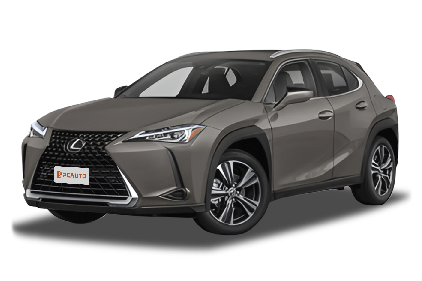Q
Are Lexus UX maintenance costs high?
The Lexus UX lands somewhere in the upper-middle range when it comes to maintenance costs for luxury cars in Malaysia, though it might be a tad more wallet-friendly compared to its German rivals in the same class. A regular service – think oil and filter changes – will set you back around RM600 to RM800, depending on whether you go straight to the dealership or an authorized service center. Lexus Malaysia does sweeten the deal with a 5-year free maintenance program (limited to a certain number of services), which takes a big chunk out of those initial ownership costs. Just keep an eye on the warranty fine print regarding non-genuine parts, though.
For the hybrid models like the UX250h, that clever hybrid system does come with a bit more complexity. If the battery pack needs replacing outside of warranty, you could be looking at RM15,000 or more. But here's the thing – Toyota's hybrid tech is pretty well-proven, so the failure rate is relatively low. Malaysian owners should also factor in how import duties can bump up parts prices. It's a good call to get your insurance through official channels to cover those potentially steep repair bills.
If budget's a concern, it's worth cross-shopping maintenance costs with other Japanese luxury alternatives like the Lexus NX or even the Toyota Harrier. Also, check if any local independent workshops have the proper certification to handle the Lexus Hybrid system – that way, you can keep quality up without necessarily paying dealership prices. All in all, the UX's running costs are right in line with its luxury badge, but for long-term ownership, you'll want to weigh up your annual mileage and how the car ages over time.
Special Disclaimer: This content is published by users and does not represent the views or position of PCauto.
Related Q&A
Q
Where is the Lexus UX manufactured?
The Lexus UX is a compact SUV from Toyota's luxury arm, Lexus. It's primarily built at Toyota's Kyushu plant in Japan, though some market-specific models might roll out of the Canadian factory too. Launched back in 2018, this little luxury runner sits on Toyota's TNGA (GA-C) platform, leaning hard into sporty styling and hybrid tech—total overkill in the best way for Malaysia's urban jungle. The hybrid setup, like in the UX 250h, is a real traffic-beater here, keeping fuel sipping in check even when you're crawling through KL or PJ.
In Malaysia, the UX lineup isn't just about one-size-fits-all. They've got the locally assembled (CKD) versions, which sweeten the deal with sharper pricing, but don't you worry—Lexus hasn't skimped on that trademark hush inside or the premium cabin feel we all love. And hey, let's not sleep on the peace of mind: every Lexus in Malaysia comes with that solid 5-year unlimited mileage warranty, and their service network's spread out across all the major cities, so help's never too far if you need it.
As Lexus' gateway into the compact luxury SUV game, the UX plugs a nice gap in their lineup. Now they've got something for everyone, from the UX up to the NX and RX, covering all sorts of budgets and wants for Malaysian buyers. Smart move, if you ask me.
Q
Does the Lexus UX hold its value well?
The Lexus UX holds its value pretty well in the Malaysian market, and that's largely down to the brand's premium image, solid reliability, and slow depreciation. As a luxury compact SUV, its hybrid variants – take the UX 250h, for example – are especially popular locally. With fuel prices being what they are, Malaysian buyers really appreciate that fuel efficiency. Plus, Lexus' complimentary maintenance program across the range, like that 5-year/100,000 km warranty, definitely gives the used car market a confidence boost.
Of course, actual resale value depends on factors like age, mileage, condition, and specs. The base UX 200, for instance, might not hold value quite as strongly as the hybrid models. If you want to maximize what you get later, I'd recommend sticking to regular servicing at authorized centers and keeping all those records intact.
Stacked up against its peers, the UX typically outperforms non-luxury brands when it comes to retaining value. But compared to German rivals? That can vary a bit depending on brand preferences. If you're a Malaysian buyer planning to switch cars within a few years, going for popular colors like white and ticking the box for advanced driver assistance systems will make your UX easier to sell down the line.
Q
What's the price of Lexus LX 570 in Malaysia?
In Malaysia, the price of a Lexus LX 570 can vary quite a bit depending on the spec and model year. Brand-new, you're generally looking at a range of around 800,000 to 1,000,000 ringgit, with the exact figure depending on the optional extras you tick and any dealer promotions on offer. Over in the used car market, prices fluctuate based on condition and mileage, typically landing between 500,000 and 700,000 ringgit.
The Lexus LX 570 has made a name for itself as a luxury full-size SUV, packing that burly 5.7-liter V8 engine, some seriously capable off-road chops, and a cabin that's all about luxury. It's a solid fit for Malaysia's diverse road conditions, handling everything from city commutes to weekend adventures without breaking a sweat.
On top of that, Lexus has built a strong reputation for after-sales service in Malaysia. They offer comprehensive warranty and maintenance packages, so owners can enjoy peace of mind with their purchase. If you're thinking about getting one, I'd definitely recommend heading to an official dealership for a test drive and to check out the latest promotions. It's also worth cross-shopping against rivals like the Toyota Land Cruiser or Mercedes-Benz GLS to make sure you're getting the perfect match for your needs.
Q
What's the price of the all-new Lexus UX?
Based on the latest Lexus pricing in the Malaysian market, the all-new Lexus UX starts at around RM243,888 for the UX 250h Luxury trim, while the range-topping UX 250h F Sport variant comes in close to RM285,888. Exact prices may vary slightly depending on optional extras, promotional campaigns, or regional dealer policies.
As a luxury compact SUV, the Lexus UX is powered by a 2.0L hybrid powertrain, delivering impressive fuel efficiency with an official figure of approximately 4.5L/100km. It also comes standard with the Lexus Safety System+, featuring active safety technologies like pre-collision warning and lane keeping assist.
It's worth noting that car pricing in Malaysia includes import duties, consumption tax, and registration fees, which is why they tend to be higher compared to some other countries. That said, Lexus Malaysia offers a 5-year unlimited mileage warranty along with complimentary maintenance services, further enhancing its value proposition.
If your budget is a bit tighter, you might also want to check out rival Japanese luxury models like the Volvo XC40 or Mercedes-Benz GLA. Just be sure to pay attention to differences in specifications and powertrain setups. We'd recommend heading down to an authorized showroom for a test drive and to get the latest promotional offers.
Latest Q&A
Q
How many miles per gallon does the Dodge Charger achieve?
The Dodge Charger's fuel economy varies depending on the specific trim and engine setup. Take the rear-wheel-drive model with the 3.6L V6, for example—it'll sip around 19-23 MPG in the city and stretch to 30-31 MPG on the highway. Step up to the high-performance 6.4L V8 HEMI, and you're looking at roughly 15-17 MPG in urban driving and 24-25 MPG out on the open road. If you opt for the even more beastly 6.2L supercharged V8 in the Charger SRT Hellcat, city fuel economy drops to about 12-13 MPG, with highway figures coming in at 21-22 MPG.
For our readers in Malaysia, keep in mind these numbers are based on U.S. EPA testing standards. Real-world fuel efficiency can vary depending on your driving style, road conditions, and fuel quality. Since Malaysia uses the metric system, you can convert these MPG figures to liters per 100 kilometers for easier reference (1 MPG ≈ 0.425 km/L).
Also, hybrid or future electric versions could offer better efficiency down the line. Before making a purchase, it's smart to check local specifications and tax policies—big-displacement engines might mean higher road taxes in Malaysia. And don't forget, regular maintenance and keeping your tires properly inflated can also help optimize fuel economy.
Q
When was Dodge Charger released?
The Dodge Charger first hit the scene back in 1966, and man, did it make a statement. As a classic American muscle car, it quickly became the poster child for power and style. That first-gen model packed some serious V8 heat, like the legendary 7.0-liter Hemi, setting the bar high for what a high-performance ride should be.
Over in Malaysia, you don't see Chargers cruising around every day—they're pretty rare birds. But when you do spot one, heads turn. Its bold, in-your-face design and brute force under the hood still hook a solid group of local gearheads.
Through the years, the Charger's gone through some major evolutions. The latest model? It's like they took that classic muscle soul and injected it with 21st-century tech. We're talking advanced driver-assistance systems, more efficient powertrains—think 3.6L V6 and 5.7L V8 options—and then there's the beastly Hellcat trim, rocking a 6.2L supercharged V8 that cranks out over 700 horsepower. Insane, right?
For Malaysian car fans, the Charger isn't just a car—it's a symbol of that wild, unapologetic American muscle spirit. Yeah, the local market's mostly dominated by Japanese and European rides, but you'll catch the occasional imported Charger rolling around, especially in enthusiast circles. Whether it's a vintage classic or a modern rocket ship, the Charger's history and raw performance have cemented its spot as an icon in car culture. And let's be real—either way, it's all about that pure, unfiltered American driving thrill.
Q
What is the sport traction control of the Dodge Charger?
In the Dodge Charger, Traction Control Sport is an electronic stability feature engineered specifically to amp up the driving fun. It dials back the traction control intervention when you're pushing the car hard, letting the rear wheels break loose a little in a controlled way. This helps you get more agile turn-in or even a little power slide, all while still keeping that baseline safety net in place.
You’ll usually find a button on the center console to kick it on. It’s right at home on a track or closed course, but for your daily grind on the streets, sticking with the default mode is the smart call for safety. Now, for our friends in Malaysia, those wet, rainy roads can up the ante on wheel spin, so definitely use this feature with a bit of extra caution.
Here’s the lowdown on how it works: sensors keep an eye on wheel speed differences, and if things start to get sketchy, the system automatically tweaks engine power or hits the brakes to keep you from losing control. Different brands slap different names on similar setups—like ESC Sport or VDC Off—but they’re all chasing that same sweet spot between safety and raw handling.
If you’re hungry to dive deeper into car electronics, check out stuff like electronic limited-slip differentials or torque vectoring. They’re all part of the tech package that makes modern performance cars handle as good as they do.
Q
How many miles can Dodge Charger travel?
For Malaysian consumers wondering about the Dodge Charger's durability, this American muscle car typically clocks in 320,000 to 480,000 kilometers over its lifespan—mileage that really hinges on how well you maintain it and your driving habits. With Malaysia's hot and rainy climate, make sure to pay extra attention to regular checks on the cooling system and rubber components. Stick to the manufacturer's recommended service interval of 5,000 to 7,500 miles (around 8,000 to 12,000 km), and using full synthetic oil will definitely help extend the engine's life. The Charger's Hemi V8 is known for being tough as nails, but stop-and-go city traffic can wear out the clutch faster. So, if you're regularly driving in congested areas like KL, consider shortening the gearbox oil change interval a bit. It's worth noting that the right-hand-drive version in Malaysia shares basically the same mechanicals as left-hand-drive models, and parts supply is solid through authorized dealers, keeping long-term ownership costs manageable. If you're eyeing a used model, focus on checking the electronics in post-2015 cars—their Uconnect infotainment systems can get laggy if not maintained, but that doesn't hurt the overall mechanical reliability of the car.
Q
How to install the cold air intake on Dodge Charger?
Installing a cold air intake system on your Dodge Charger is a solid mod that can boost both engine performance and fuel efficiency. First off, you’ll need to grab the right cold air intake kit—make sure it’s compatible with your Charger’s engine model. Here in Malaysia’s hot climate, go for intake tubes made from heat-resistant materials like aluminum alloy or high-density plastic; they’ll hold up better over time. The installation steps involve yanking out the stock air filter box, disconnecting the sensor plugs, fitting the new intake piping and high-flow air filter, and making sure all connections are sealed tight to keep unfiltered air out of the engine. Once it’s all set up, check if the check engine light comes on—if it does, you might need an OBD2 scanner to reset the ECU so it adjusts to the new air intake volume.
Basically, a cold air intake works by lowering the temperature of the incoming air, which increases oxygen density and improves combustion efficiency. But heads up: during Malaysia’s rainy season, you’ll want to add a waterproof shield to prevent the engine from sucking in water. Also, keep in mind that mods like this could affect your factory warranty, so it’s smart to check with an authorized service center before diving in. If you’re chasing even better results, pairing it with an exhaust system upgrade can help, but make sure everything stays within JPJ’s noise and emissions regulations.
View MoreRelated News

Lexus LS may turn into a six-wheel MPV, so why does the LS Concept use a six-wheel design?
MichaelOct 16, 2025

Lexus launches LS 500 Heritage Edition in the United States, which may be discontinued afterwards
Kevin WongSep 28, 2025

The 2026 Lexus IS has made its global debut, and after a redesign, its appearance more closely resembles that of a Toyota
RobertSep 11, 2025

Lexus Drops Full EV Plan, Will Push Hybrids and EVs Together
RobertAug 11, 2025

Lexus IS will undergo a major redesign, and more Lexus models may disappear in the future
Kevin WongAug 4, 2025
View More







 Cars
Cars




Pros
Cons